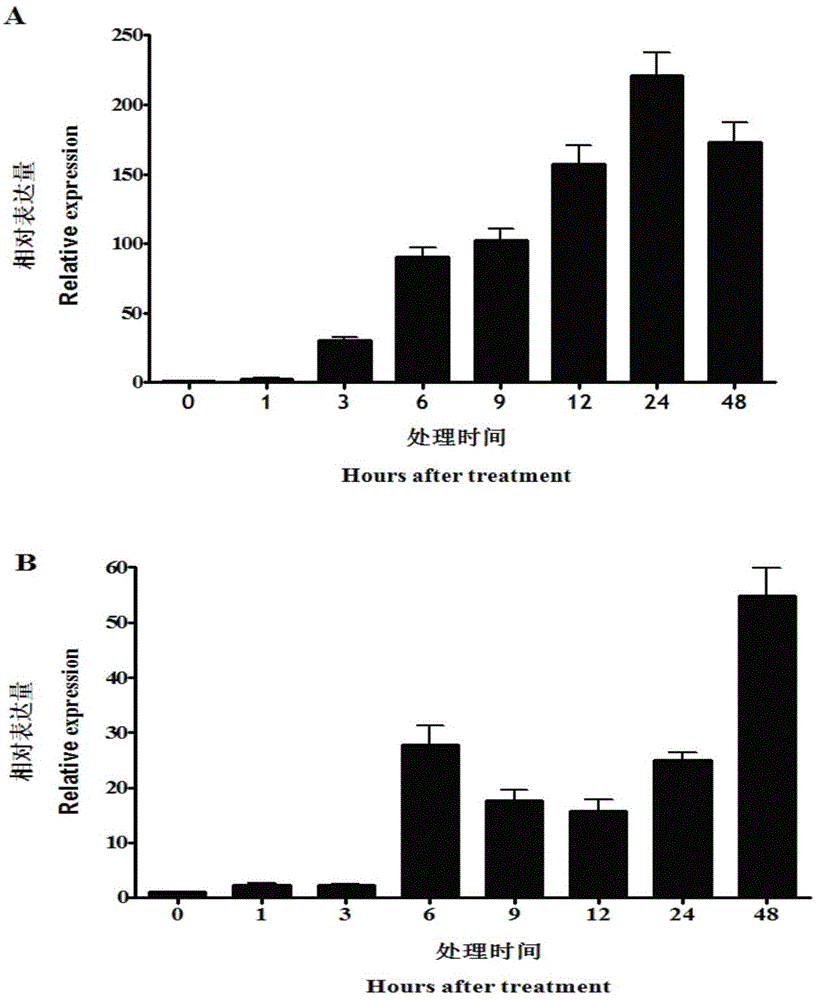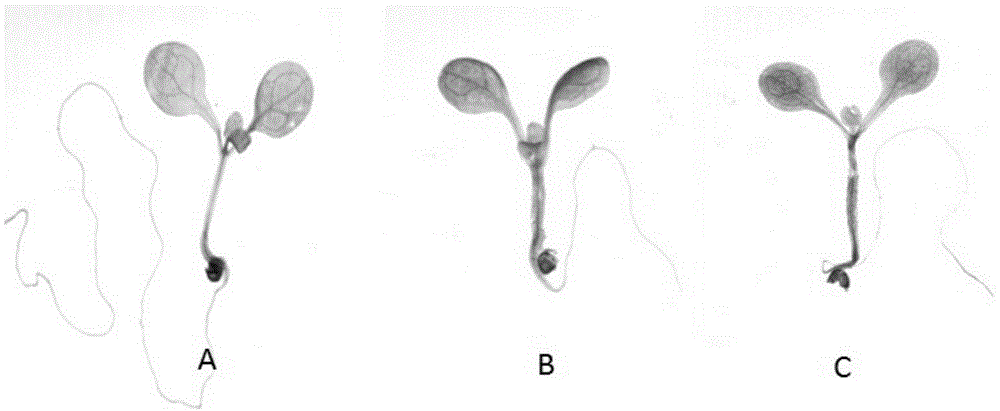Plant osmotic stress inducible promoter and application thereof
A promoter and sequence technology, applied in the field of molecular biology, can solve problems such as hindering the normal growth and development of plants, destroying the metabolic balance of plants, etc., to achieve the effect of improving gene expression and enhancing ability
- Summary
- Abstract
- Description
- Claims
- Application Information
AI Technical Summary
Problems solved by technology
Method used
Image
Examples
Embodiment 1
[0022] Example 1 Expression analysis of osmotic stress-induced expression gene TaDeh1 in Shimai 15
[0023] 1.1 Material Handling
[0024] Selected Shimai 15 seeds were cultured in a light incubator with tap water until the stage of two leaves and one heart, the culture temperature was 22±1°C, and the light was 14 hours a day. Select 20-25 seedlings with consistent growth and development, put them in petri dishes, and treat them with 20% polyethylene glycol (PEG8000). Leaves and roots were stored in a -70°C refrigerator after quick freezing in liquid nitrogen; the experiment was set up with 3 replicates.
[0025] 1.2 Wheat total RNA extraction
[0026] RNAiso Plus (TaKaRa) was used to extract total RNA from 15 roots and leaves of shimai, and RNase-free DNase I (TaKaRa) was used to remove residual DNA in the total RNA.
[0027] 1.3 Synthesis of the first strand of cDNA
[0028] Using PrimeScript TM 1st Strand cDNA Synthesis Kit (TaKaRa) was used for first-strand cDNA synt...
Embodiment 2
[0037] Example 2 Cloning of osmotic stress-induced expression gene TaDeh1 promoter of Shimai 15
[0038] 2.1 Plasmid extraction from Shimai 15BAC mixed pool
[0039] Prepare the BAC mixed pool plasmid extraction reagent according to the molecular cloning guide, and carry out the plasmid extraction according to the following steps.
[0040] 1) Collect the bacterial solution twice in a 50ml centrifuge tube, centrifuge at 10,000rpm at 4°C for 5min, and remove the supernatant;
[0041]2) Add 6ml of pre-cooled solution I and shake to mix;
[0042] 3) Add 6ml of solution II, mix upside down, and place at room temperature for 5 minutes;
[0043] 4) Add 6ml of pre-cooling solution III, mix well by inverting up and down, and place on ice for 10 minutes;
[0044] 5) Centrifuge at 12,000rpm at 4°C for 10min;
[0045] 6) Take the supernatant, add 0.8 times the volume of isopropanol, and place it at room temperature for 20 minutes;
[0046] 7) Centrifuge at 12,000 rpm at 4°C for 10 mi...
Embodiment 3
[0070] Example 3 Construction of osmotic stress-induced expression gene TaDeh1 promoter expression vector (pTaDeh1pro: GUS)
[0071] The pCAMBIA1831Z vector and the pMD18-T simple vector containing the TaDeh1 promoter were digested with BamHI and HidIII respectively, and the large fragment of the pCAMBIA1831Z vector and the fragment of TaDeh1pro were recovered respectively. 4 After ligation with DNA ligase (NEB), DH5α competent cells were transformed, and the constructed promoter expression vector was verified by digestion with BamHI and HidIII and sequencing; see pDeh1pro: GUS expression vector map figure 2 .
[0072] 3.1 BamHI and HidIII digestion of pCAMBIA1831Z vector and pMD18-T simple vector containing TaDeh1pro
[0073] Plasmids were extracted using the GenStar plasmid mini-extraction kit. The plasmid was digested and digested in a water bath at 37°C for 3 hours, and the digested product containing TaDeh1pro and the large fragment of the pCAMBIA1391Z vector were reco...
PUM
 Login to View More
Login to View More Abstract
Description
Claims
Application Information
 Login to View More
Login to View More - R&D
- Intellectual Property
- Life Sciences
- Materials
- Tech Scout
- Unparalleled Data Quality
- Higher Quality Content
- 60% Fewer Hallucinations
Browse by: Latest US Patents, China's latest patents, Technical Efficacy Thesaurus, Application Domain, Technology Topic, Popular Technical Reports.
© 2025 PatSnap. All rights reserved.Legal|Privacy policy|Modern Slavery Act Transparency Statement|Sitemap|About US| Contact US: help@patsnap.com



